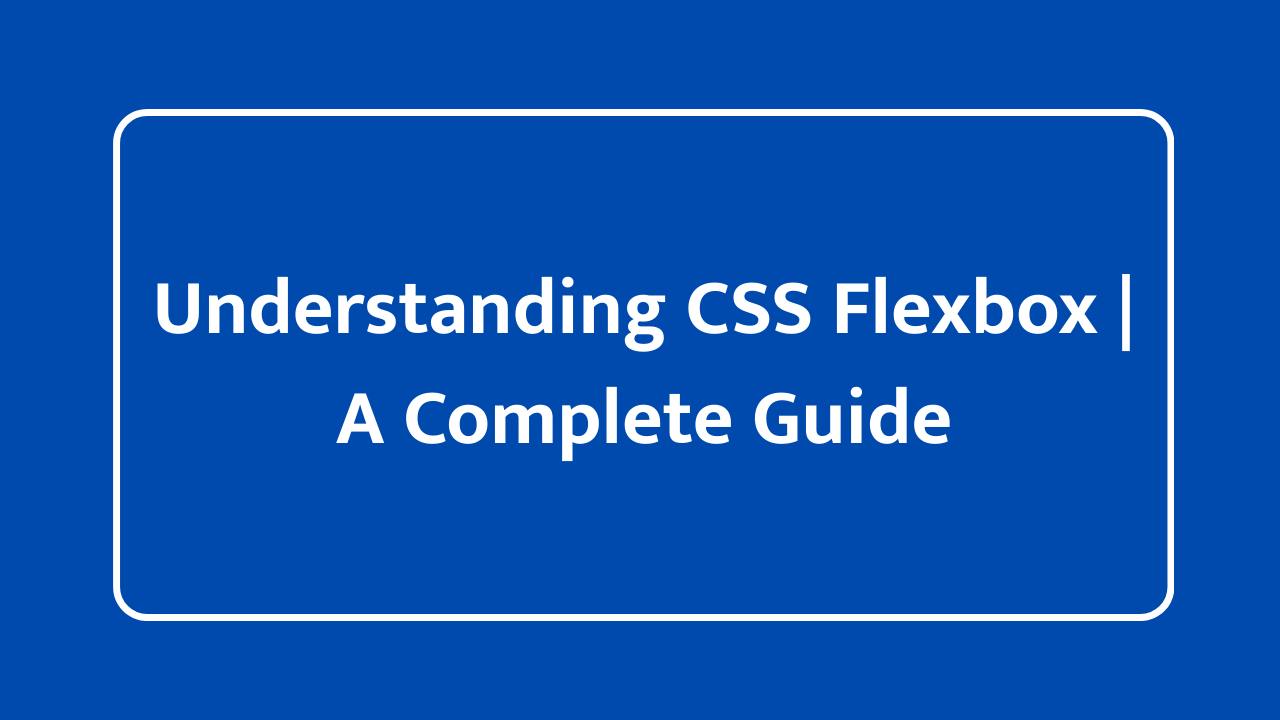Understanding CSS Flexbox | A Complete Guide
CSS Flexbox (Flexible Box Layout) is a powerful layout model in CSS that allows you to design responsive and flexible web layouts with ease. It is great for building complex layouts without relying on floats or positioning. Flexbox provides more control over how elements are arranged within a container, making it easier to align and distribute space between items in a container.
Here’s a complete guide to understanding CSS Flexbox:
1. CSS Flexbox Basics
The core concept of Flexbox revolves around two main elements:
- Flex Container: The parent element that holds the flex items.
- Flex Items: The child elements inside the flex container.
You define a flex container by applying the display: flex or display: inline-flex property to a parent element.
.container {
display: flex;
}
display: flex: Creates a block-level flex container.display: inline-flex: Creates an inline-level flex container.
2. CSS Flexbox Container Properties
Once you declare an element as a flex container, you can control how the flex items inside it are aligned, spaced, and wrapped using various flexbox properties:
flex-direction
The flex-direction property defines the direction in which the flex items are placed in the container. It can take the following values:
row: The default value, which aligns the items horizontally (left to right).row-reverse: Aligns the items horizontally but in reverse order (right to left).column: Aligns the items vertically (top to bottom).column-reverse: Aligns the items vertically but in reverse order (bottom to top).
.container {
display: flex;
flex-direction: row; /* Items are placed horizontally (default) */
}
flex-wrap
By default, flex items will try to fit on a single line. If there isn’t enough space, they will overflow. You can control this with flex-wrap:
nowrap(default): All items are displayed in a single line.wrap: Items will wrap to the next line when they run out of space.wrap-reverse: Items will wrap to the previous line (in reverse order).
.container {
display: flex;
flex-wrap: wrap; /* Allows items to wrap onto new lines */
}
justify-content
The justify-content property defines how the flex items are aligned along the main axis (the direction defined by flex-direction). It accepts the following values:
flex-start: Items are aligned to the start of the container (default).flex-end: Items are aligned to the end of the container.center: Items are aligned to the center of the container.space-between: Items are spaced out evenly with the first item at the start and the last item at the end.space-around: Items are spaced evenly with equal space around them.space-evenly: Items are spaced evenly with equal space between and around them.
.container {
display: flex;
justify-content: space-between; /* Evenly spaces items with space between */
}
align-items
The align-items property defines how the flex items are aligned along the cross axis (perpendicular to the flex-direction). It can have the following values:
flex-start: Aligns items at the start of the cross axis.flex-end: Aligns items at the end of the cross axis.center: Aligns items at the center of the cross axis.baseline: Aligns items based on their baseline (ideal for aligning text).stretch(default): Items stretch to fill the container’s cross-axis.
.container {
display: flex;
align-items: center; /* Vertically centers the items */
}
align-content
The align-content property is used when there is extra space on the cross axis (when wrapping items). It aligns the lines of flex items within the container:
flex-start: Aligns the lines to the start of the container.flex-end: Aligns the lines to the end of the container.center: Aligns the lines in the center.space-between: Distributes space between the lines.space-around: Distributes space around the lines.stretch: Stretches the lines to fill the container.
.container {
display: flex;
flex-wrap: wrap;
align-content: center; /* Aligns wrapped lines to the center */
}
3. CSS Flexbox Item Properties
Once you have a flex container, you can control how individual flex items behave using the following properties:
flex-grow
The flex-grow property specifies how much a flex item should grow relative to other items. It accepts a positive number (typically a whole number):
flex-grow: 1: The item will grow to fill available space.flex-grow: 0(default): The item will not grow beyond its initial size.
.item {
flex-grow: 1; /* Allows the item to grow and take available space */
}
flex-shrink
The flex-shrink property specifies how much a flex item should shrink when there is not enough space in the container. It accepts a positive number:
flex-shrink: 1: The item can shrink.flex-shrink: 0: The item will not shrink.
.item {
flex-shrink: 1; /* Item can shrink if needed */
}
flex-basis
The flex-basis property sets the initial size of a flex item before any growing or shrinking occurs. It can take any length value (e.g., px, em, %) or auto (default).
.item {
flex-basis: 200px; /* The item will initially take up 200px */
}
flex
The flex shorthand property is a combination of flex-grow, flex-shrink, and flex-basis. It’s often used to simplify the definition of how items grow, shrink, or have a base size:
.item {
flex: 1 1 200px; /* flex-grow: 1; flex-shrink: 1; flex-basis: 200px */
}
align-self
The align-self property allows you to override the align-items setting for a particular flex item. It can have the following values:
auto(default): Follows the container’salign-itemsvalue.flex-start,flex-end,center,baseline,stretch: Same asalign-items, but for individual items.
.item {
align-self: center; /* Centers this particular item */
}
4. Example: CSS Flexbox Layout
Here is a simple example of a flexbox layout with multiple flex items:
<!DOCTYPE html>
<html lang="en">
<head>
<meta charset="UTF-8">
<meta name="viewport" content="width=device-width, initial-scale=1.0">
<title>Flexbox Example</title>
<style>
.container {
display: flex;
flex-wrap: wrap;
justify-content: space-between;
align-items: center;
height: 100vh;
}
.item {
flex: 1;
margin: 10px;
padding: 20px;
background-color: lightblue;
text-align: center;
}
/* Responsive design: On smaller screens, items take full width */
@media (max-width: 600px) {
.item {
flex: 1 1 100%; /* Items take up full width on small screens */
}
}
</style>
</head>
<body>
<div class="container">
<div class="item">Item 1</div>
<div class="item">Item 2</div>
<div class="item">Item 3</div>
<div class="item">Item 4</div>
</div>
</body>
</html>
In this example, the .container is a flex container, and the .item elements are flex items. When the screen size is less than 600px, the items will stack vertically to fit the available space.
CSS Flexbox is a powerful and flexible layout tool for building responsive web designs. It allows you to align and distribute elements within a container with ease. By understanding and mastering Flexbox properties, you can create complex layouts without the need for floats, positioning, or hacks. Practice using Flexbox to gain a deeper understanding and improve your web layout designs.
ALSO READ : How to Create Responsive Web Pages Using HTML and CSS


![Top Python Interview Topics: A Beginner’s Guide for Students [Latest 2025]](https://developer.thrend.in/wp-content/uploads/2025/11/ChatGPT-Image-Nov-18-2025-02_21_01-PM.png)
